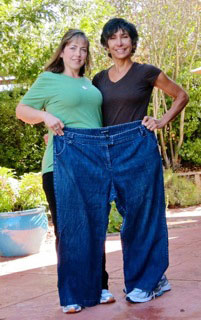
How to Work With an Overweight Client
Client: Kerry
Personal Trainer: Sue D’Alonzo, owner, SueDFit-Workout Personal Training and Health Coaching
Location: Pinole, California
Inspired by fear. Kerry was afraid when she first reached out to personal trainer Sue D’Alonzo in March 2013. The limitations Kerry’s body presented from carrying excess weight had become more severe. She feared these limitations would make it increasingly difficult for her to keep up with her young son, and she worried that trying to do so might result in injury. Kerry also dealt with nagging hip pain. Although Kerry expressed these concerns to her physician, she was never advised to lose weight. Eventually, Kerry turned to D’Alonzo for help.
“When I met Kerry, she was 316 pounds,” says D’Alonzo. “She was motivated and determined to change.”
Solid foundations. One of the initial roadblocks Kerry and her trainer faced was time. Kerry had two children and owned a business, so finding the time to train was difficult. The pair initially settled on a once-per-week meeting conisting of a 30-min-ute workout and 15 minutes of nutrition discussion and planning. While Kerry was receptive and capable during the work-outs—initial assessments proved that she was flexible, agile and strong—the more challenging aspect of her transformation was food. D’Alonzo learned immediately that her new client had a taste for all things sugary and regularly visited the fast-food drive-through. D’Alonzo recommended that Kerry use the MyFitnessPal app, which helped her understand how much sugar she was consuming daily. Unfortunately, Kerry was hit-or-miss on tracking food intake.
An “A-ha!” moment occurred when Kerry reluctantly agreed to meet D’Alonzo at the grocery store for a 90-minute lesson on food labels and how to shop for optimal health. “This was a pivotal moment,” D’Alonzo remembers. “Subsequently, coffee became just coffee; lunches came from her kitchen; fast food became a thing of the past; and the scale started moving downward.”
By January 2014, Kerry had dropped 70 pounds.
Movement focused. At the beginning of their in-home training program, D’Alonzo developed a simple circuit-style workout that consisted of biceps curls, sit-ups, push-ups and more. The trainer wasn’t overly concerned with the exercises at the outset.The primary goal was to get Kerry to move around as much as possible without making her too fatigued or frustrated.
“My second goal was to show Kerry that she could do it, and she did. I always stayed within her abilities for that day.
Pain-free. At the beginning of the program, D’Alonzo was mindful of Kerry’s hip pain, but as the training progressed and diet changes were implemented, the pain disappeared. As Kerry continued to lose weight, D’Alonzo felt more comfortable increasing the challenge of the work- outs. She incorporated weighted squats and lunges as well as boxing exercises into the program. D’Alonzo also encouraged a resistant Kerry to walk on a regular basis and to wear a pedometer.
“Today Kerry makes sure she walks up and down the stairs at work and goes for a walk at least 5 days a week,” says D’Alonzo.
So far, Kerry has lost 105 pounds and trimmed 8 inches from her waist and the same from her hips. She intends to lose another 25 pounds, adds D’Alonzo, who believes Kerry will achieve her goal.
The power of compassion. One of the primary takeaways of this experience is the emphasis on patience, says D’Alonzo. “This is a wonderful process that has to be done with a plan and realistic expectations, which at times were difficult for Kerry. She wanted faster results even though she was always right on track. I learned that being persistent and encouraging; listening to Kerry’s concerns; and providing her with knowledge and resources were key to her success. I also learned not to give out my way of life but rather to work within her reality.”
D’Alonzo emphasizes kindness and understanding when working with someone like Kerry. “Unfit, obese or overweight people need guidance in a compassionate manner,” she says “Most of them are intimidated by exercise and exposing their bodies. Be sensitive and aware of the language you use. Be specific with goal setting and don’t overwhelm. Encourage sincerely.”